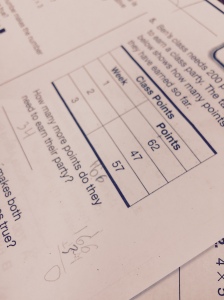Today while working with some third graders in my intervention group, I had that moment that I know you all have as a teacher. When you pose a story to be solved (I’m tired of calling them problems…is it ok to call them stories to be solved?), and the students just start panic crunching numbers. Like throwing numbers around and adding up every number they hear in the story.
Today it was simple story, one that I know these three could probably picture in their minds, or at the very least draw:
“There are two trees, each one has 15 cherries. How many cherries are there altogether?”
I’ve been reading about the benefits of using vertical white board surfaces, to get students to do more thinking. One student wrote 2 + 15 = 17 with her partner. She was CONVINCED (and there was nothing I could say to change her mind), that because there were two trees and 15 cherries, those two numbers must be added together. The other student knew to add 15 and 15, but used an inefficient strategy of drawing each individual cherry on the two trees. I will address the inefficient strategy issue in another post, but today I really want to address the idea of students just crunching numbers without thinking.
I think for too long, students who struggle with math have been led down this road of not have the proper exposure to tools, drawings and then the abstract notation of mathematics. I see tools disappearing as early as first grade in classrooms, which we all KNOW are critical in child development. Not only are tools disappearing, but I see math programs that encourage abstract notation before connecting tools and drawings to that notation.
Take for example, 3 x 14 or 14 x 3. This student was able to build it with tiles (showing an understanding of area), then was able to take a shortcut and show an area model (without the tiles inside), and eventually use partial product notation to solve.



Somewhere along the line, students who struggle to problem solve missed these connections. They look at you with panic in their eyes as they try to figure out what you are asking and what they have to do. Then in pure desperation instead of solving, they just start mindlessly crunching numbers, not making any connections whatsoever.
Here are some ways that I intervene:
- Make tools available, have them act it out first, then draw what they made. Don’t worry at this point if the notation is correct, can they make sense of the problem with tools? At first it might be helpful to provide the tool, then the next time have a few different ones to choose from. Start watching if they are choosing an appropriate tool.
- Write a hint in a different color. Explain that the hint will lead them in a different direction, and that they need to “unthink” some part of what they did. In the case of the cherry trees, I drew an additional tree next to the one they had already drawn and wrote 15 under it. That little hint made all the difference.
- Look for places they are actually making connections and compliment them on that. The student who wrote 2+15 was actually thinking about multiplication! I told her that, but then asked the two of them to back up and think about what that would mean if they multiplied those two numbers. Find SOMETHING that you like about what they did. Those compliments stick, and they remember it again next time and will use it.
- Don’t give up on them, and have high expectations. I hear this said over and over again, “My ‘low’ students have a really hard time problem solving.” When you call them low, you will expect nothing but low performance.
- Try not to give the answer at the end. Explain that problem solving is about thinking, not the answer. This will enrage them at first, but eventually they will start thinking instead of spitting out an answer. They will also see that they need to persevere while solving instead of waiting for the teacher to give the strategy and answer in the end.
- Have them compare two strategies next to each other. Have the students look for similarities and difference.
- Choose random partners whenever possible. This allows students to learn different strategies from others, and it keeps your groups fresh.
Students who struggle in mathematics can be excellent problem solvers. It’s so critical that we believe this, and that we continue to challenge them at high levels with the right supports.




















